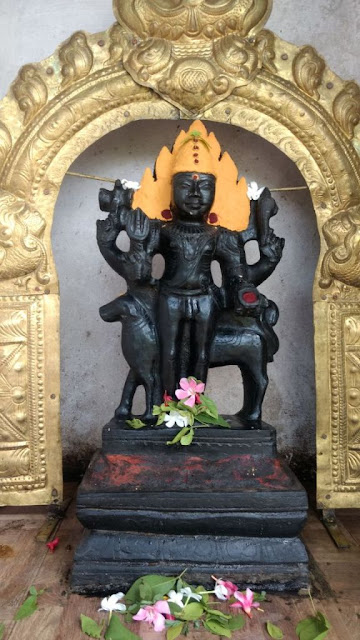Sivayoginathar
Temple, Thiruvisainallur – The Temple
This
temple is facing towards east with five tiered
Rajagopuram. The
Temple has two prakarams. Nandi, Balipeedam and Dwajastambam can be
found immediately after the Rajagopuram. Nandhi is placed between Bali Peedam
and Dwajastambam which is very unusual. Normally in other temples, Dwajastambam
is placed in between Balipeedam and Nandhi.
It is to be noted that you can
see the idol of Nandi with its head turning to a side. It is believed that
those who pray to him here during the Pradosham (Twilight period in the evening
on the 13th day of every lunar fortnight) will be absolved of all their past
sins. There is another Gopuram leading to the inner prakaram housing the
sanctum. The sanctum sanctorum consists of sanctum, antarala and Arthamandapam.
Presiding
Deity is called as Sivayoginathar / Yoganandheeswarar / Vilvaranyeswarar / Puraathaneswarar. He is housed in the sanctum in
the form of Shiva Lingam. Lord is a Swayambhu Moorthy and is facing east. Seven
hair locks can be seen in the body of Shiva Lingam. It is believed that Lord
Suryan (Sun) worships Lord Shiva of this
temple by directing his rays on the lingam every year for three days
(on 1st, 2nd and 3rd) in the Tamil month of Chithirai (Apr-May). Special
poojas are performed during these days.
The legend has it that eight
Siva Yogis merged with the lingam here after attaining salvation. Hence Lord
Siva got the name Sivayoginathar. The sanctum is similar to Vaprabandha type
with Arthapadma, a feature not mentioned in Vastu Shastra texts. The
beautiful large vyalas in the prathimukha are among the most
powerfully conceived of their kind. It is of modest proportions and consists of
the sanctum and its attached mandapam (hall).
The two cover a total length of
15.3 m, with its vimana measuring about 15.3 m.
The mandapam is a hall of 4 central pillars, and a vestibule provided
at its back, leading to the sanctum, which is a square chamber of 3.7m. The
lion motif is absent in the pillars though it reappeared in friezes where ever
suited. The pillars in the interior are typical of Chola art. The
usual deities are enshrined in the central niches outside the wall of the
sanctum.
The toranas over the
south and west niches are of good workmanship, especially that on the west,
which is perhaps the finest in South India. Narthana
Vinayakar, Dakshinamurthy, Mahavishnu, Brahma and Durga are the Koshta Idols
located around the sanctum walls. Chandikeswarar can be seen in his usual
location.
There is a beautiful relief on the wall of the sanctum
which depicts Lord Brahma and Lord Vishnu worshiping Lord Shiva. Mother is called as Soundara Nayagi / Santha Nayagi. She
is housed in a separate south facing shrine facing the Sun Clock. As Lord Siva is in deep meditation inside,
Ambal waits outside for him looking at the Sun Clock.
There is a sundial in the 35-feet-high
periphery wall of this
temple opposite to Goddess Parvathy’s shrine. It is believed that
this clock is more than 1200 years old built during Parantaka Chola I period. This
clock is constructed in such a way to measure the route of the sun from the
sunrise in the morning till the sunset in the evening. It is said that during
the colonial period, the British added numerals to make calibration
easier.
It is carved out of granite and
shaped like a semi-circle with numbers from morning 6.00 to evening 6.00 are
carved around. It has a three-inch-long brass needle permanently fixed at the
center of a horizontal line. As the sun casts its rays on the needle, the
shadow of the needle indicates the right time. This shows the architectural,
astronomical and scientific knowledge of the people during the Chola period.
There are 4 Bhairavar Idols
placed in a row namely, Gnanakala Bhairavar, Swarnakarshana Bhairavar, Unmatha
Bhairavar and Yoga Bhairavar are in north east corner of the
temple premises along with Bala Saneeswarar. These 4 Bhairavar Idols
collectively called as Chathur Kala Bhairavars. It is significant to worship
them in the Ashtami day. In some of the Shiva temples, Lord Vishnu is seen
alone; but, here he appears as Lakshmi Narayanan, along with his spouse
Lakshmi. He is housed in a shrine in the outer prakaram.
There are shrines and idols of Vinayakar,
Murugan with his consorts Valli & Deivanai, Pancha Lingams (Bhumi Lingam,
Jala Lingam, Agni Lingam, Vayu Lingam and Akasha Lingam representing the five
elements of Earth, Water, Fire, Air and Sky respectively), Gajalakshmi,
Mahalingeswarar, Niruthi Vinayakar, Naga Kanni, Saptha Mathas, Suryan, Saint Uyyavantha
Nayanar, Naalvar, Sekkizhar, Chandran and Navagrahas in the prakaram.
There are eight Theerthams and
eight trees associated with this
temple. The prominent Theertham is Jatayu Theertham and Sthala
Vriksham is Vilvam tree. Vilvam, Vanni, Punnai, Makizhamaram, Aalamaram, Nelli,
Arasamaram are the trees found in this
temple. There are about 97 inscriptions in this
temple, dating back to Parantaka Chola I, Rajaraja Chola I and
Rajendra Chola I. have also made several
endowments to this
temple. This
temple houses the festival images of the Thirundudevankudi
Temple nearby.






































